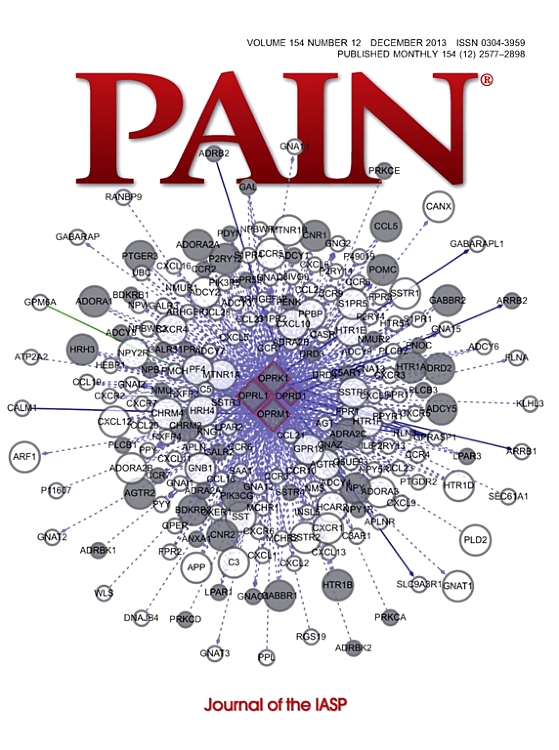在雄性小鼠背部疼痛模型中,椎间盘损伤诱导生发中心形成、原感觉抗体产生和慢性伤害性致敏。
IF 5.9
1区 医学
Q1 ANESTHESIOLOGY
引用次数: 0
摘要
越来越多的证据表明,椎间盘损伤与适应性免疫系统的激活有关。这种反应的关键未知特征是产生前感觉性抗体的机制和时间过程以及所涉及的抗体类别。本研究使用雄性野生型(WT)和muMT小鼠(缺乏成熟B细胞)的腰椎间盘穿刺(DP)模型来评估前感觉性免疫反应。采集DP后33周的血清,进行免疫球蛋白(Ig)M和IgG鞘内注射和抗原结合实验。收集脊髓和椎间盘进行定量聚合酶链反应、免疫组化和免疫组化分析。在muMT小鼠中,椎间盘穿刺损伤的影响很小,但在WT小鼠中,它会引起后爪异常性痛、痛觉过敏和握力无力,并在6个月后逐渐消退。脊髓炎症细胞因子和补体成分的表达在DP后慢性上调,在1至3周达到峰值。脊髓IgM和IgG自身抗原结合和沉积在DP损伤后10 ~ 20周达到高峰。腰椎淋巴结免疫染色显示b细胞生发中心的形成始于DP损伤后3周,并在10至20周达到峰值。在WT小鼠DP后3至20周内收集的IgM和IgG鞘内注射在muMT DP小鼠中具有预知性。针对B细胞的先发制人的药物干预对早期伤害性致敏没有影响,但在DP损伤后10周给予WT小鼠时,致敏性降低。总的来说,这些数据支持从组织损伤到慢性肌肉骨骼疼痛状态转变的前感觉性自身免疫假说。本文章由计算机程序翻译,如有差异,请以英文原文为准。
Spinal disk injury induces germinal center formation, pronociceptive antibody production, and chronic nociceptive sensitization in a male mouse back pain model.
Accumulating evidence suggests that spinal intervertebral disk damage is associated with activation of the adaptive immune system. Key unknown features of this response are the mechanism and time course for the generation of pronociceptive antibodies and the antibody classes involved. This study used the lumbar spinal disk puncture (DP) model in male wildtype (WT) and muMT mice (lacking mature B cells) to evaluate pronociceptive immune responses. Sera collected up to 33 weeks after DP were purified for immunoglobulin (Ig)M and IgG intrathecal injections and antigen binding experiments. Spinal cords and disks were collected for quantitative polymerase chain reaction, western, and immunohistochemical analyses. Disk puncture injury in muMT mice had minimal effect, but in WT mice, it induced hindpaw allodynia, hyperalgesia, and grip weakness that gradually resolved after 6 months. Spinal cord expression of inflammatory cytokines and complement components was chronically upregulated after DP, peaking at 1 to 3 weeks. Increased IgM and IgG autoantigen binding and deposition in the spinal cord peaked at 10 to 20 weeks after DP injury. Lumbar lymph node immunostaining demonstrated B-cell germinal center formation beginning at 3 weeks and peaking at 10 to 20 weeks after DP injury. Intrathecal injection of IgM and IgG collected between 3 and 20 weeks after DP in WT mice was pronociceptive in muMT DP mice. Preemptive pharmacologic intervention targeting B cells had no effect on early nociceptive sensitization but reduced sensitization when administered at 10 weeks after DP injury in WT mice. Collectively, these data support the pronociceptive autoimmunity hypothesis for the transition from tissue injury to chronic musculoskeletal pain state.
求助全文
通过发布文献求助,成功后即可免费获取论文全文。
去求助
来源期刊

PAIN®
医学-临床神经学
CiteScore
12.50
自引率
8.10%
发文量
242
审稿时长
9 months
期刊介绍:
PAIN® is the official publication of the International Association for the Study of Pain and publishes original research on the nature,mechanisms and treatment of pain.PAIN® provides a forum for the dissemination of research in the basic and clinical sciences of multidisciplinary interest.
 求助内容:
求助内容: 应助结果提醒方式:
应助结果提醒方式:


